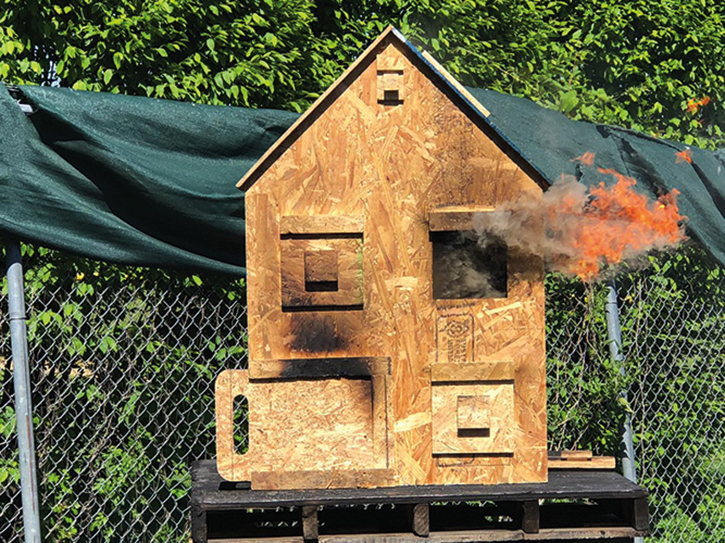
The Fire Department of New York (FDNY), in conjunction with UL Firefighter Safety Research Institute (UL FSRI), hosted a three-day FSRI Fire Dynamics Boot Camp. The train‐the‐trainer course was designed to enable fire service leaders and instructors to incorporate the most current research findings involving fire behavior and firefighting tactics into their department’s training programs. The boot camp focused on the how and why of fire dynamics, beginning with small tabletop fire experiments (photo 1), continuing with reduced-scale fire development (photo 2) and flow path models, and ending with full‐scale hose stream and fire demonstrations (photo 3) to understand how to apply fire dynamics information in the street. All of these evolutions were backed by data and videos of full‐scale fire experiments conducted by UL with fire department support, often with FDNY support.
RELATED FIREFIGHTER TRAINING
First-Due Battalion Chief: Complacency
Getting Ahead of the Top-Floor Fire
Modern House Fires: Effects of Research on Strategy and Tactics
The boot camp’s goal: Attendees would gain an improved understanding of fire dynamics. The FDNY and UL FSRI invited the following departments: the Boston (MA) Fire Department, Chicago (IL) Fire Department, Houston (TX) Fire Department, Los Angeles (CA) City and County Fire Departments, Philadelphia (PA) Fire Department, and San Francisco (CA) Fire Department.

(1) Photos by author unless otherwise noted.

(2)
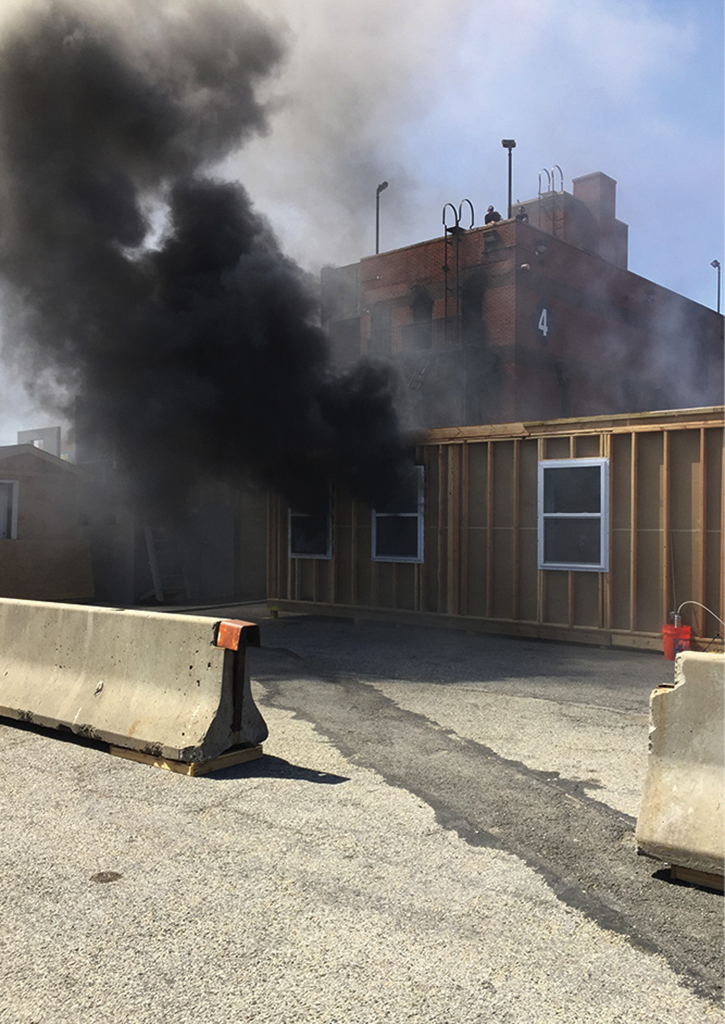
(3)
In this immersion training, students mingled to learn and share the information presented in the seminar as much as possible. This has proven to be an extremely effective method in previous boot camps and other training. This was no different—during the evening sessions in the hotel, the attendees formed small groups and discussed what was brought forth that day. This setting with the diverse group of attendees provided a unique opportunity for the FDNY to develop extremely important relationships that can be leveraged in the future for collaboration and problem solving with others from similar, larger urban fire departments.
The week started off with a simple question: “Why does the fire service need to embrace fire dynamics and change?” We looked at some of the challenges facing the fire service today, as follows:
The number of fires are down since the 1970s by more than half.
Firefighters can’t go to enough fires anymore to put all the pieces together.
Experience and knowledge must coexist; you can’t gain experience if you don’t know what’s happening.
You need to know the how to go with the why.
The challenge is that, since fires are way down, we need to rely more on the knowledge that we can garner from fire dynamics demonstrations such as those done by UL. When I joined the fire service in 1986, firefighters were taught certain basic tenets. We never knew why; we took them at face value and just adhered to the culture. Some of the edicts my senior men taught me in the firehouse and at the fire academy were the following:
The roof firefighter must get the roof.
Never open the nozzle on smoke.
Whip the nozzle around clockwise to push smoke and heat out the windows.
Never let the door close behind you.
No progress after 20 minutes? Rethink your strategy.
The Roof Firefighter Must Get the Roof
Coordinating vertical ventilation with other fireground activities was not considered traditionally; the subject came up at the boot camp. The old thinking: Open the roof to relieve conditions in the building as soon as possible; there wasn’t any thought of controlling the door to the fire apartment. When I was a firefighter, you could always tell when the roof bulkhead was open and when it wasn’t. The UL study, “The study of effectiveness of fire service vertical ventilation and suppression tactics in single family homes” emphasized that vertical ventilation needs to be coordinated as well. I believe that the fire instructors back in the day had five-story tenements in mind when they made the original roof firefighter statement. Although the UL study was based on a one-story dwelling, the new science here is applicable (photo 4).
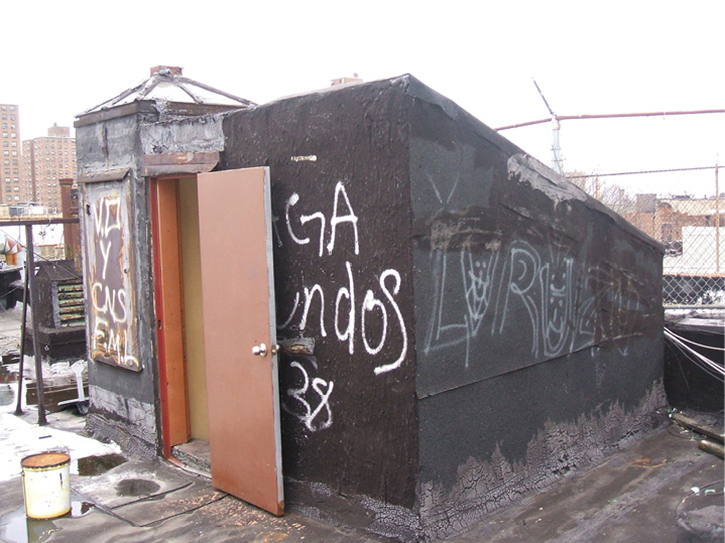
(4)
The Firefighter’s Workplace Today
The fire service’s workplace has changed; home furnishings are one of several significant factors. Compared to legacy furnishings, the modern home furnishings feature synthetic materials that have significantly higher heat release rates. This accelerates the fire development stages, creating an increased potential for ventilation-limited fire conditions prior to fire department arrival. Most importantly, the time between tactical ventilation and flashover is two minutes for the modern fire and more than eight minutes in the legacy fire. The legacy fire could be described as forgiving pertaining to ventilation. The firefighters have time to recover after poorly timed ventilation or an uncoordinated attack since they had approximately eight minutes to adapt prior to flashover. The time to recover in the modern fire is approximately two minutes or 25 percent of the legacy time. This data supports the statement,“You are not fighting your grandfather’s fire anymore” (photo 5).

(5) Photo by Underwriters Laboratories.
Control the Access Door
Tactically, door control has several considerations. Most importantly, it is temporary. You must open a door to gain access into a burning home, but if you limit the air inlet, you limit the fire’s ability to grow. The fire dynamics of door control are fairly simple. If you have a ventilation-limited fire and you limit the air, then you limit the amount of heat released. Although this does not completely cut off the oxygen supply, it slows it, which slows fire growth. In these experiments, limiting the air supply delayed the flashover for minutes. The more the door is closed (i.e., the smaller you make the door opening) and the longer you keep it closed, the slower the fire will grow. Control the door until water is applied to the fire. Once water goes on the fire and the attack crew has the upper hand—that is, when the water is absorbing more energy than the fire is creating—then firefighters may fully open the door to ventilate.
Coordinate Attack with Vertical Ventilation
“Taking the lid off” does not guarantee positive results. Vertical ventilation is the most efficient type of natural ventilation. Although it allows the largest amount of hot gases to exit the structure, it also allows the most air to be entrained into the structure. You must coordinate vertical and horizontal ventilation with fire attack. To ensure that the fire does not get larger and that ventilation works as intended, you must apply water to convert the fire from a ventilation-limited fire (it needs air to grow) to fuel-limited fire. Once the water has the upper hand (i.e., the water is absorbing more energy than the fire is creating), ventilation will begin to work as intended. This will happen more quickly with vertical ventilation than with horizontal ventilation, assuming similar vent sizes.
How big a hole? A 4- × 8-foot hole over a ventilation-limited fire does not allow more smoke and hot gases to exit than it creates. A 4- × 8-foot hole above the fire in each of the houses alone did not improve conditions or make ventilation-limited fire conditions into fuel-limited conditions. When water was applied to the fire to reduce the burning rate, the fire became a fuel-limited fire. Once the fire was fuel limited, the larger the hole, the better conditions became for any potential victims or firefighters operating inside the structure (photo 6).
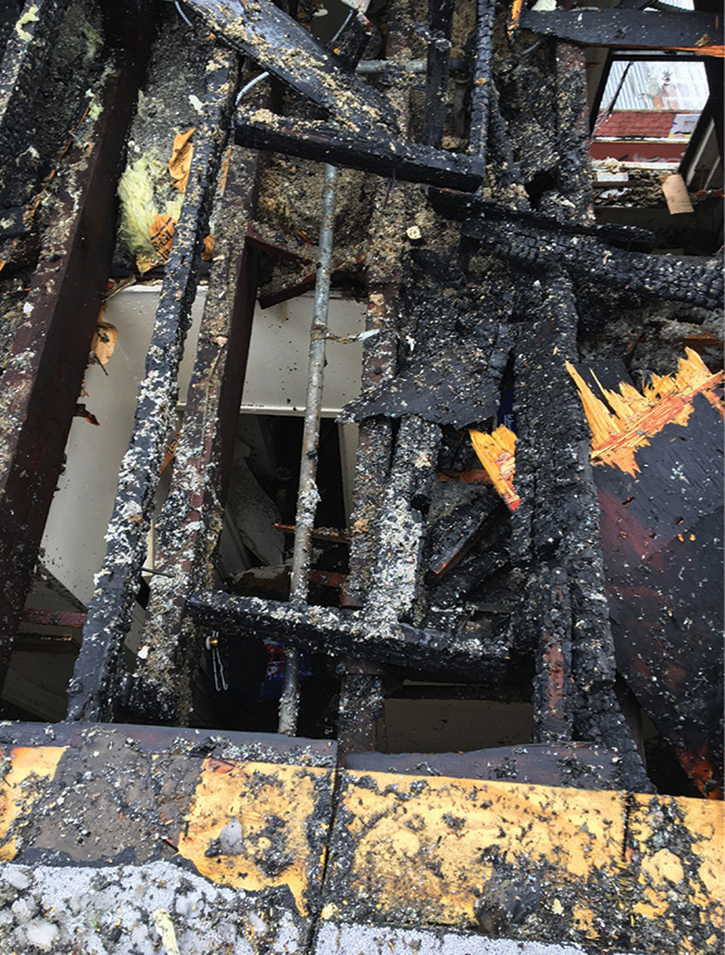
(6)
Never Open the Nozzle on Smoke
Smoke Is Fuel
Incident commanders should identify when smoke is rich in fuel and in search of heat or oxygen. In a typical fire situation, smoke is a visible, flammable, heated suspension of solids (carbon), aerosols (hydrocarbons), and fire gases (acetylene, carbon monoxide, hydrogen cyanide, methane) that are toxic, flammable, and volatile.1 Smoke that is black, high-volume, turbulent velocity, and ultra-dense is indicative of impending autoignition and should be cooled as if it were fire.2
Turbulent, dense smoke under pressure could indicate a ventilation-limited fire that will react abruptly to small changes in ventilation. The presence of both heavy smoke (fuel) and high heat could indicate that the fire is ventilation limited and will be extremely sensitive to any increase in ventilation, already having two of the three sides of the fire triangle in place. Smoke that is dark and dense contains heated unburned fuel and is an active hazard. Look especially for turbulent dense smoke under pressure, which could indicate the combination of high heat and dense fuel, as the rapid expansion of superheated gases is generating pressure.
Flow Water on Hot Fuel
Removing heat from superheated unburned fuel removes one side of the fire triangle from that environment and can prevent ignition of that fuel should sufficient air be introduced. In ventilation-limited fire conditions, the smoke is often so hot it is damaging and heating surfaces, creating more fuel, just as fire does.
Crawling underneath a superheated unburned smoke layer can result in the transfer of significant thermal radiation (heat) to the firefighters’ turnout gear. Without cooling the environment, the hot gas will transfer energy from above to the firefighters via convection. Using the reach of the hose stream to cool the ceiling above reduces the risk of turnout gear failure and ventilation-induced flashover.
Cool as You Advance
The belief that structural protective gear will protect a firefighter as he advances to the compartment of origin without applying water and that applying water prior to reaching the compartment will have negative consequences does not fit with modern fuel loads and fire development.
Additionally, the thought that the suppression crew must be in the compartment before applying water is just not practical. The compartment of origin becomes untenable for firefighters in full protective gear once it reaches flashover.
Apply Water Quickly from the Best Position
Quickness matters. UL experiments have demonstrated that quick water application from the exterior, applied as soon as possible, increases the potential survival time for building occupants and provides safer conditions for firefighters performing search and rescue. In fact, experiments have demonstrated that the traditional practice of increasing ventilation to a ventilation-limited structure fire by opening doors, clearing windows, or cutting the roof increased the fire hazards and the potential for a rapid transition to flashover.
Rather than making conditions more hazardous, applying water directly into the fire compartment as soon as possible has been shown to be the most effective means of suppressing the fire. Research has shown that applying a hose stream through a window or door into a room involved in a fire significantly lowered room temperatures everywhere in the home. Even a small amount of water, applied as quickly as possible regardless of where it is from, improved conditions inside the burning home. In cases where front and rear doors were open and windows had been vented, the application of water through one of the vents enhanced conditions throughout the structure
Where is the fuel? Likely everywhere. Where are the heat and oxygen? Depends, but when a fire has become ventilation-limited, there are two means of controlling its growth—limiting the oxygen and cooling with water.
The flow paths and the flow of air determine the direction of fire spread. Risks increase for firefighters when they operate in the exhaust portion of the flow path and flow of fire, airborne fuel, and heat. Choose the most advantageous attack point and tactics.
Hose and Stream Placement
The door closest to the apparatus should not dictate line/stream placement. The plan of fire attack and tactics used should be as dynamic as the fires themselves. Develop alternatives to using the front door—procedures that you can use when adapting to how the fire presents, train on them, and have options that the team understands.
Fire Compartment: Water and Timing Matter
Effective application of water into the fire compartment, whether from the interior (via the doorway) or from the exterior window, has a positive impact. The fire’s heat release rate is reduced, temperatures near to and remote from the fire are reduced, and the rate at which toxic gases are produced slows, making tactical ventilation effective. With all else being equal, base the tactical choice of from where to apply water more on how quickly you can knock back the fire and less on from where you are applying the water.
The sooner the stream enters the compartment, the sooner the temperatures are reduced. This is largely because of hose streams that are limited to line of sight. A fire service hose stream does not bounce off surfaces, nor can it make turns around corners. To apply water to a compartment, the crew must be able to see into the compartment under normal visibility.
If the Water Gets to Where It Needs to Go, You Don’t Need Much
When dealing with a room-and-contents fire, the available oxygen limits the energy release rate (ventilation-limited). You don’t need a large amount of water to absorb the energy being released and knock back the fire.
Although less is not necessarily better, when a water supply has not been established, or in areas where no municipal supply exists, do not delay water application to establish a water supply. Even a 500-gallon supply tank can be sufficient to knock back two rooms of fire if the attack crew can get the water where it needs to go.
During the 25 suppression experiments conducted using a 1¾-inch handline flowing 150 gpm to 165 gpm, the most water used for initial knock back and suppression was less than 250 gallons. When attacking a single room-and-contents fire in a residential structure, knock back and initial suppression are often possible with less than 100 gallons, in some instances less than 75 gallons. Even flowing while moving to the compartment of origin did not use more water than that available in a 500-gallon supply tank.
Establishing a water supply and deploying a backup handline are two critical steps to help provide a safety factor to the operations on the fireground if the primary attack line encounters difficulty in applying water directly where it needs to go.
Whip the Nozzle Around Clockwise to Push Heat and Smoke Out the Windows
Water Can Impact the Flow Path
Fire service hose streams can entrain air and thus create flow. This entrainment has the potential to alter the flow path during interior and exterior suppression tactics.
During an interior attack, applying water down the hallway, with a vent opposite, in a method that entrains air (e.g., whipping a smooth bore nozzle around clockwise) can alter the flow path such that the hot gases are no longer flowing over the heads of the firefighters as they advance.
Isolate the Fire, and Keep It Isolated
Interrupting the flow of air to a ventilation-limited fire can slow the growth of the fire. Closing windows, interior doors, exterior doors, and chimney openings can keep a fire ventilation-limited and cooler for longer, putting hose streams into service so heat can be removed prior to the introduction of oxygen. Ventilation should be an intentional tactic, employed at the right time (after water application) and in close coordination with other fireground activities. Isolation should be initiated as opportunities present and maintained until water application occurs, and any tactical ventilation should be coordinated with and ordered by command.
Never Let the Door Close Behind You
Fire Flows from High Pressure to Low Pressure
Hot (high-pressure) fire gases will rise and move toward the lower pressure created by ventilation openings, filling the spaces between the fire and the ventilation outlet with heated smoke (suspended fuel). Outside air will also be drawn into the base of the fire through ventilation openings. The flow path of air determines the direction of fire spread.
Consider Opening and Operating Through an Exterior Door as Ventilation
While forcing and making entry may be necessary to fight the fire, it must also trigger the thought that air is being fed to the fire and the clock is ticking before either the fire is extinguished or conditions become untenable, jeopardizing the safety of everyone in the structure. Each new ventilation opening provides a new flow path to the fire, and vice versa. This can create very dangerous conditions when there is a ventilation-limited fire.
Once you open the front door, pay attention to the flow through it. A rapid inrush of air or a tunneling effect could indicate a ventilation-limited fire. Never get stuck between the fire and where it wants to go without water or a door to close.
You cannot effectively manage flow pathes unless you identify them first. Once identified, you need to control openings whether they are windows or doors and whether they are used to enter the structure or as part of a tactical ventilation plan. Door control at fire suppression access points is important.
Venting does not always lead to cooling; only ventilation that is well-timed and coordinated with water application leads to improved conditions.
Coordinate fire attack with any ventilation, including opening doors and windows.
Even fires that appear to be ventilated are often ventilation limited. In experiments, even making multiple ventilation locations did not provide enough ventilation to create fuel-limited fires from ventilation-limited fires. Each of the experimental fires grew when provided with additional air. Even with ventilation openings functioning, the fires remained ventilation limited and responded with rapid growth to the additional air. Fires actually grew faster with vent openings made, as higher temperatures were produced relative to those in a ventilation-limited condition. In cases of functioning vertical ventilation, rapid fire progression is highly probable, and coordination of fire attack with ventilation is paramount.
No Progress After 20 Minutes? Rethink Your Strategy
Lightweight construction can fail rapidly when exposed to heat.
The evolution from legacy to modern lightweight construction has resulted in structures that exhibit significant differences in heat flux, heat transfer, temperatures, and energy release rates when fires occur. Construction differences such as larger volumes, open floor plans, higher-flammability contents, and engineered support systems have resulted in significantly shorter firefighting operational time for firefighting and shorter time to collapse under fire conditions.
Home contents now include increased uses of flammable synthetic materials such as plastics, foams, and textiles.
In general, modern residential structures have larger interior volumes than legacy residences. This is certainly true of single-family residences but also in multifamily structures such as the now common mixed-use pedestal-style construction. This larger volume of air facilitates the growth and sustainment of a fire.
Open floor plan designs used in modern construction limit compartmentalization of fires, contributing to rapid smoke and fire spread and making fires more difficult to contain.
Improved insulation and tighter construction practices may eliminate the typically observable size-up clues, such as visible smoke. The use of soft ridge vents tends to seal up attics under heat conditions, and thermal pane windows require more energy before self-ventilating.
In 2008 experiments, the fire containment performance of a combustible floor-ceiling assembly representing typical legacy construction without a ceiling was 18:35 minutes; for a floor-ceiling assembly supported by engineered I-joists, it was just 6:00 minutes. Differences in similar flooring systems protected by a single layer of gypsum board were 79:00 minutes compared to 26:43 (Table 1).
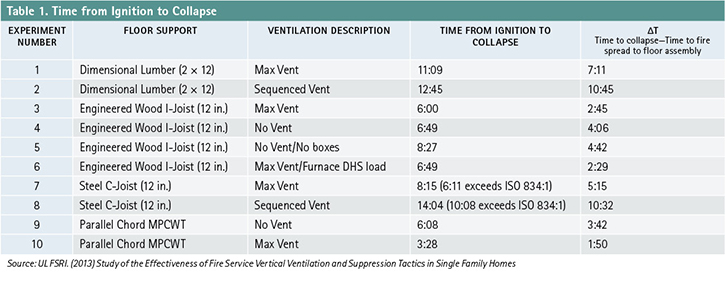
Synthetic fuel loads found in homes today produce much more energy when burning than the natural fuel loads found in homes of previous generations.
Homes now produce more energy and produce more unburned fuels, which accumulate and spread throughout a structure and move with the flow path. Rapid fire spread, explosive ignition of this heated unburned fuel, or flashover can occur quickly when oxygen is introduced.
One very important difference is that modern fires take less time to progress to flashover. Fires often have already progressed to flashover prior to fire department arrival and frequently have progressed past flashover. Whether flashover was attained or not, they are often in a stage of ventilation-limited decay, making even small changes to ventilation of the compartment a key factor in rapid fire development.
Rapid fire development significantly increases the chance that a fire will be in a ventilation-limited state on fire department arrival.
One experiment demonstrated that flashover in modern room furnishings occurs between 3:30 and 4:45 minutes, as compared to 29:30 and 34:15 minutes in legacy room furnishings—a 700% difference.
These are just a few of the items that I was taught very early in my career by the senior firefighters at the time. Firefighting is constantly evolving; the art of firefighting is constantly trying to keep up with the changes in the building industry. Many factors contribute to the changes. Engineers are always looking to build with cheaper and lighter materials. As Frank Brannigan observed, “We’re replacing mass with math.”
It takes time for both sides to adjust. I can remember when the hydraulic forcible entry spreader was introduced into the FDNY. Ladder companies were getting into the fire area in seconds, way before the hoseline was ready, and the result was increased injuries. Like anything else, it will take time for the next generation of firefighters to implement the lessons learned until it becomes part of the norm.
In the past several years, the FDNY has introduced the new cockloft nozzle to deal with fires on the top floor of large H-type buildings. It was slow in the beginning, but now it has become an accepted tool in combating cockloft fires. I am sure that in a few years, firefighters won’t be able to remember a time when it wasn’t used, and they will ask themselves, “How did we ever fight these fires without the cockloft nozzle?”
The UL FSRI Fire Dynamics Boot Camp was a huge success; it gave us all an opportunity to be in the same room discussing science-based research, experience, and new trends in the fire service and how we will deal with them in the future.
References
Underwriters Laboratories Firefighter Safety Research Institute. (2013) “Study of the Effectiveness of Fire Service Vertical Ventilation and Suppression Tactics in Single Family Homes.” https://bit.ly/2Kc8UIA/.
National Fire Protection Association. (2003) Fire Protection Handbook, 19th edition.
DANIEL P. SHERIDAN is a 33-year veteran of the Fire Department of New York, where he is a battalion chief. He has worked in Harlem and the Bronx for most of his career. He is a national instructor and the founder and chief operating officer of Mutual Aid Training Group.

